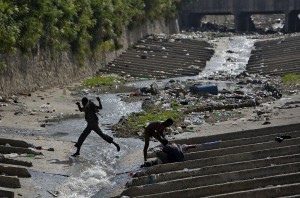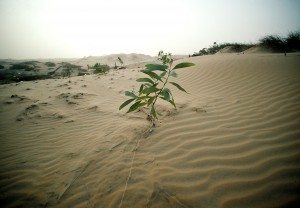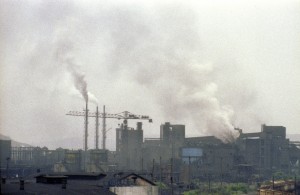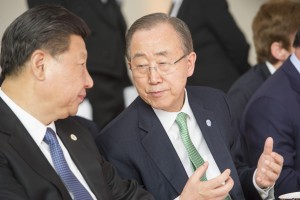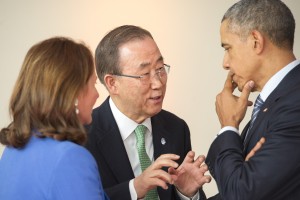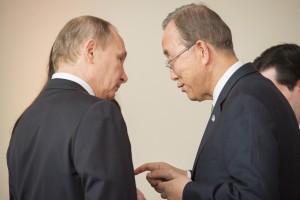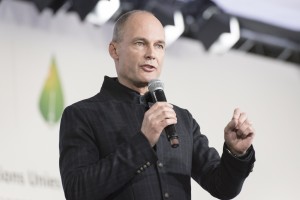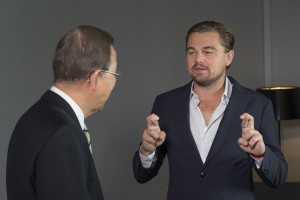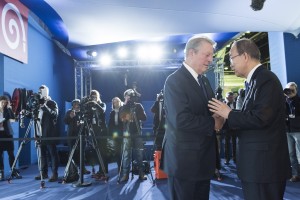After the Copenhagen fiasco in 2009 when no agreement was reached, the subject of climate change looked dead and buried. Yet, this time in Paris, something positive happened at COP21. That’s the 21st Conference of the Parties (COP), i.e. the countries that have signed onto the United Nations Framework Convention on Climate Change (UNFCCC) back in Rio, at the 1992 Earth Summit. It took twenty-three years to get from there – in Rio – to here in Paris.
So, was COP21 a success or yet another failure? Actually, it was both
On Saturday, December 12th, at 7:30 pm, after 11 days of negotiations between 195 countries, including a 24 hour delay and a last minute panic caused by a typo in the text that suggested that one sentence in the agreement was binding when it was intended to be voluntary, an agreement was reached, met by a standing ovation. Called the “Paris Agreement” by the French Foreign Affairs Minister Laurent Fabius and President of COP21, it was agreed to by “consensus” as is the habit at the United Nations, even though one country, Nicaragua, insisted that its perplexities be put on record.

In the photo: Secretary-General Ban Ki-moon attend High Level Closing of the Summit of Local Leaders hosted by Ms. Ann Hidalgo, Mayor of Paris, and Mr. Michael Bloomberg, Special Envoy of the Secretary-General on Cities and Climate Change – Photo Credit: UN Photo/Eskinder Debebe
If you listen to French President Hollande or the Secretary General of the United Nations Ban Ki-moon, it was a huge success, a “historic” agreement, the start of a new era. President Obama concurred, seeing the accord largely as a personal victory, the result of his agreement last year with President Xi Jinping of China to reduce greenhouse gas emissions and of the new regulations he issued this year to reduce carbon pollution from power plants. “We’ve transformed the United States into the global leader in fighting climate change,” he told the New York Times.
Yet, the deal falls far short of what is needed to slow global warming and reverse the environmental damage already done.
Scientists report that the world in 2015 has already gone one full degree above pre-industrial levels. Based on the intentions expressed by countries in their INDCs sent to the COP21 secretariat, the future does not look promising. INDCs are Intended Nationally Determined Contributions, i.e. national plans to cut greenhouse gas emissions independently arrived at by every country: that is the system developed to run the negotiations in Paris, thus avoiding the impasse that had plagued COP in Copenhagen where countries had flatly refused the imposition of greenhouse emission targets by the UN. But those submitted so far at the Conference don’t go far enough. An estimate published during the two-week talks showed that the INDCs so far received would only limit global temperature rise by 2.7 C: at such temperatures, some 250 million people living in coastal regions and low-lying islands would be at risk, turning them into an unmanageable tsunami of climate refugees.
Related Articles: COMING TOGETHER ON CLIMATE CHANGE
H₂O STORIES: INTERVIEW WITH BOB SANDFORD, THE UNITED NATIONS VOICE FOR WATER
A Success: The Agreement Established a RoadMap
The Agreement opens with a promising call to strengthen the global response to the threat of climate change (Article 2):
(a) Holding the increase in the global average temperature to well below 2 °C above pre-industrial levels and to pursue efforts to limit the temperature increase to 1.5 °C above pre-industrial levels, recognizing that this would significantly reduce the risks and impacts of climate change;
(b) Increasing the ability to adapt to the adverse impacts of climate change and foster climate resilience and low greenhouse gas emissions development, in a manner that does not threaten food production;
(c) Making finance flows consistent with a pathway towards low greenhouse gas emissions and climate resilient development.
And all this should be done reflecting “equity and the principle of common but differentiated responsibilities and respective capabilities, in the light of different national circumstances” – UN language meaning the demands of developing countries should be respected. Moreover, measures are to be taken, as spelled out in Article 4, “in the context of sustainable development and efforts to eradicate poverty”. In fact, references to the economic plight of developing countries and the need to lift people out of poverty abound, such objectives are part and parcel of SDG 13, the climate change Sustainable Development Goal. This is normal practice in the UN structure and SDG 13 is further woven into many of the 17 Sustainable Development Goals (SDGs) adopted by the UN General Assembly in September 2015.
In short, fair is fair, the big polluters should stop polluting and pay, poor countries will get help.
For the first time, the world is able to agree on a road map – a road map that, if all goes well, should take us to a world that is only 1.5 degree Celsius warmer than it was in the pre-industrial age.
A world where coastal regions and small island states, like the Marshall Islands, might not find themselves under water, irretrievably lost. If, however it is 2 degrees warmer, then, as per the best available scientific evidence, all those people who live on coasts or on low-lying islands will be under water…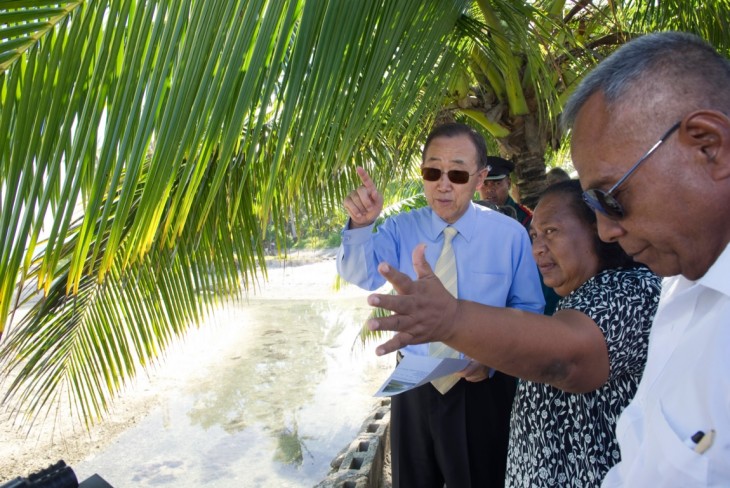
In the photo: Secretary-General Ban Ki-moon (left) is guided through Abarao, a village affected by climate change in the island nation of Kiribati.- 05 September 2011 – Photo Credit: UN Photo/Eskinder Debebe
What does this “road map” consist in?
1. A timetable: after the Agreement has been ratified – it is open for signature by UN member countries for one year, starting with a signature ceremony to be held in New York on 22 April 2016 – and even before it is fully launched in 2020, the review process will be “strengthened” and a first review of what countries are proposing will be done and will be verified with a “global stocktake” in 2023; two years later, countries are expected to make further emission reductions; the idea is to review progress every 5 years and an adjustment and/or overhaul of policies to fight global warming will be made, with no backsliding allowed;
2. Goals: (1)To peak greenhouse gas emissions “as soon as possible” and achieve a balance between sources and sinks of greenhouse gases in the second half of this century; (2) to keep global temperature increase “well below” 2 degrees C (3.6 F) and to pursue efforts to limit it to 1.5 C.
3. Funding to developing countries to help in the transition to clean energy and protect “carbon sinks” (in particular, forests – there is a big article dedicated to them): a minimum $100 billion every year to provided by developed countries (with the help of others if possible, read: China), starting in 2020.
4. A monitoring capacity through a comprehensive institutional system designed to capture progress and identify problems; this machinery is manned by UN staff and technical experts and is, as always in the UN system, supervised by the signatory countries according to a precise, agreed-to schedule (once a year at the COP regularly held every December);
What is very striking in reading the agreement, is the complex institutional engine that has been built to go down that road – an array of committees, panels of scientists and donor funds, even a couple of climate change “champions” to keep public opinion on the alert.
There are six basic functions the institutional system must serve:
1. Monitor: keeping tab of “national contributions” to fighting climate change in a “public registry” maintained by the UN secretariat and reviewing progress made;
2. Scientifically “inform” the process, identifying what the effects are on the ground and what additional measures need to be taken for “adaptation” to global warming – a recurrent exercise of “global stocktake” that continues to be entrusted to the scientists of the Intergovernmental Panel on Climate Change, that you will recall, was set up in 1988 and has since regularly issued reports keeping public opinion informed about global warming;
3. Provide “financing” to developing countries: developed countries have agreed to provide developing countries at least $100 billion annually (it’s a “floor”, not a ceiling), starting in 2020; the entities involved are the Green Climate Fund, the Global Environment Facility, the Least Developed Countries Fund and the Special Climate Change Fund, administered by the Global Environment Facility. As of November 2015, the Green Climate Fund, created in 2011, had already received pledges for over $10 billion from 38 state governments ($3 billion from the US) and is now operational and expected to play a key role.
4. Support “research” into appropriate technical solutions, including the “development and enhancement of endogenous capacities and technologies”, entrusting two UNFCC bodies with the task, the Technology Executive Committee and the Climate Technology Centre and Network ;
5. Provide “capacity-building” by setting up the Paris Committee on Capacity-building to enable developing countries to themselves manage and address climate-change issues.
6. Promote “transparency” mainly through the mechanism of technical expert reviews that would track progress made and offer assistance to improve or correct shortcomings (Article 13).
This is an impressive institutional framework to implement the Agreement and manage the world’s fight against global warming. A 12-member Ad Hoc Working Group on the Paris Agreement is the lead implementation mechanism, closely interwoven in the current COP machinery, with clearly defined reporting procedures, thus ensuring oversight from UN member countries.
And yet, the Agreement has not convinced everyone.
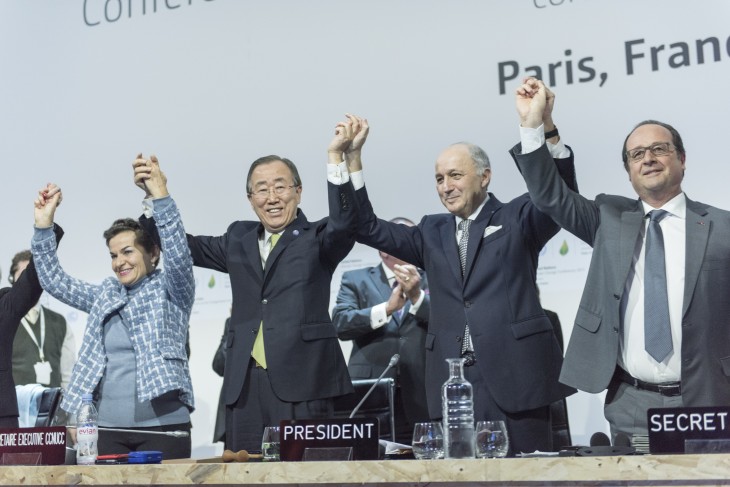
In the photo: SG delivers remarks at the closing ceremony of COP21
A Failure: It does Not Go Far Enough
First, it’s a framework for concerted action more than a step-by-step plan. Countries have resisted oversight, they view it as an infringement on their sovereignty, particularly countries like the United States, India and Saudi Arabia – but not only. The list of national egos is long…In a world that does not accept the imposition of emission targets, the “technical review” process (described in Article 13) becomes essential, not just for “transparency” but to ensure that real progress is made – but as all such processes, it could easily fall prey to political pressure.
Second, goals are vague, flexible and voluntary. There are no penalties for missing targets. The language of the agreement is filled with what countries “should” do rather than “shall” do – though “shall” applies more often to developed than developing countries. Apart from the 1.5 degrees Celsius that is not even defined as an exact target – countries are merely enjoined to “pursue efforts to limit the temperature increase to 1.5 °C ” – there are no other numbers in the agreement.
Three, the financing provided to developing countries – assuming it is ever actually provided – falls far short of what is needed. The total cost of mitigating and adjusting to climate change could come to as much as $44 trillion according to a 2014 report by the International Energy Agency – by comparison, $100 million a year is a drop in the bucket, although undoubtedly a first (if timid) step.
Conclusion: It is a Good Start
Even though there are no numerical targets and just about everything is flexible and voluntary and there is not enough money on the table, there are two aspects that are highly positive:
1. The language in the agreement makes it clear, when it calls for a “peak” in the emissions of greenhouse gas “as soon as possible”, that this should be done following the best possible science. Both what is “possible” and what is required to achieve the goal of climate change control is indicated by scientists. Thus the UN Intergovernmental Panel on Climate Change continues to play a key role in the process – even an enhanced one.
2. Peer pressure and moral suasion; this is a favorite UN tool and it has been shown to work again and again. In fact, before and even during the Conference in Paris, countries didn’t want to show up empty.handed: almost everyone submitted its contribution: INDCs currently add up to 188 countries out of a total 195.
And finally, there are the forces that make UN conferences and resolutions binding overtime.
What starts as a willing, voluntary coalition of countries that are simply showing goodwill to achieve a common goal slowly turns into a de facto state of affairs, where not achieving the goal becomes political suicide.
Countries are forced into the Agreement, pushed by public opinion. No backtracking allowed! The “international community” puts to shame the laggards and evaders.
Who is the international community?
Green business, Bill Gates calling for research into clean energy and pouring billions into it. Civil society, the Climate Action Network and leading civil society NGOs, from Christian Aid to Greenpeace, from the Sierra Club to WWF. Powerful foundations from environmentally-conscious corporations to charities, NGOs operating in the field and indigenous population representatives. A diverse world keeping watch over what the UN – i.e. state governments – are doing. Throwing a constant spotlight on climate issues and how they are addressed at the UN.
And it’s working. The effect is already felt among businessmen far beyond the circle of committed people like Bill Gates and Richard Branson; top bank executives from Goldman Sachs, Citibank and others were in Paris, usually attending related side events; a series of CEO from major companies like Unilever, DuPont, Coca Cola, General Mills, Hewlett Packard have joined in to express support before and during the talks.
And mediating over all this, the UN staff committed to implementing the Paris Agreement – people professionally invested in climate change issues. They are the ones running the machinery that makes possible the world debate around global warming. They began working in the 1980’s, following on the Brundtland Report from the UN World Commission on Environment and Development, published in 1987, that rang in the concept of sustainable development; they helped create the UN Intergovernmental Panel on Climate Change, packing it with scientists; they worked in Rio organizing the 1992 Earth Summit and they haven’t stopped since, preparing documents for the delegates, registering UN resolutions and now keeping tabs on countries’ INDCs, keeping track of progress achieved, calling on scientists to ensure transparency and that nobody is cheating…
Those are the people behind the scenes that nobody thinks about – and yet, without them, none of these UN conferences could have happened. They are manning the COP 21 machinery. And together with civil society and like-minded government delegates (they do exist!) they constitute a form of “soft power” that is pitted against the vested interests of the fossil fuels industry and petro-states – not to mention the desire of developing countries to develop as quickly and as cheaply as possible, which means having recourse to cheap fossil fuels.
Who will win, how long will this fight take? Nobody knows, but one thing is certain, mankind’s survival depends on the outcome. Does India really want to experience Beijing-style pollution to bring electricity to its 300 million citizens that need it? Scientists tell us that now one in eight deaths in the world is associated with air pollution, do we have to wait for that number to double?
In the cover: Secretary-General Ban Ki-moon look out at the Eiffel Tower from UNESCO Headquarters in Paris, France. Photo Credit: UN Photo/Rick Bajornas



